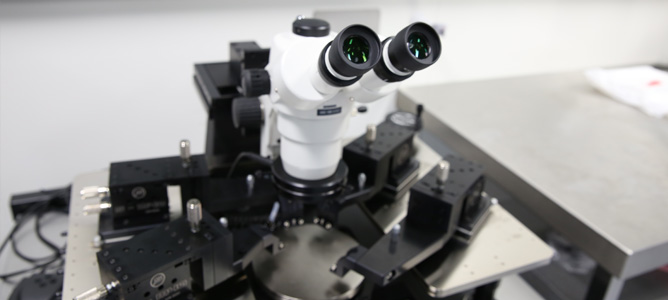Successful ARC grant funds new equipment

Through generous contributions by MCN partner institutions, as well as two successful Australian Research Council (ARC) grants, the MCN has been able to install new imaging and characterisation equipment in the Class 10,000 cleanroom. This collaborative approach to funding and operating valuable equipment delivers benefit to all parties, with MCN’s expert staff on hand to run and maintain the equipment in an open-access environment, while minimising duplication.
Through the ARC LIEF scheme (2014), as well as contributions from Monash University, Victoria University and Deakin University, a grant entited “Micro Nanofluidic Characterisation Facility” has funded a Signatone WL-1160 RF/microwave probe station, associated spectral and network analysers, a scanning current microscope and a tensile testing instrument at MCN.
Useful for IV curve generation, measurement of sheet resistance and microwave probing, the Signatone probe station is designed for high-frequency (up to 67 Ghz), high-power, and millimetre wave applications where non-resonant operation is critical.
Its key features include 150mm & 200mm manual X-Y motion control, 50mm x 50mm microscope stage control and separate contact/platen height control with up to 30mm Z motion control of the plate. It holds up to four S-96MW microwave micropositioners and features a vibration isolation table
Applicants on this grant include Associate Professor Adrian Neild, Dr Mainak Majumder, Dr Tuncay Alan, Dr Jean-Michel Redoute, and Associate Professor Wenlong Cheng from Monash University, Professor Stephen Gray, Professor Mikel Duke and Dr Tze Huei Lai from Victoria University, and Associate Professor Abbas Kouzani, Dr Alexey Glushenkov, Professor Lingxue Kong and Dr Xiujuan Dai from Deakin University.
A recent ARC LIEF grant awarded funding for a new Near-field Scanning Optical Microscope at MCN, as well as a shared instrument between Monash University and the Australian Synchrotron and also an upgrade to a system at La Trobe University. For two months a year the spectroscopy system will be coupled to the IR beamline at the Australian synchrotron, to provide full IR spectral coverage available to all Australian and New Zealand scientists. A confocal raman spectrometer will be upgraded to the ultraviolet to provide spectra at less than 150 nanometre resolution. These systems will provide a unique Australian resource for nanoscientists, biomedical researchers and materials scientists requiring molecular information on the nanoscale.
This grant was co-funded under the MCN LIEF policy which contributes cash investment towards collaborative grants and encourages partners to pool resources to acquire cutting edge capabilities.
Applicants on this grant include Professor Donald McNaughton, Professor Douglas MacFarlane, Associate Professor Wenlong Cheng, Professor John Beardall and Dr Qiaoliang Bao from Monash University, Associate Professor David Beattie from the University of South Australia, Dr Evan Robertson, Dr Adam Mechler, Associate Professor Brian Smith, Dr Marc Kvansakul, and Associate Professor Matthew Perugini from La Trobe University, Dr Mark Tobin, Dr Dominque Appadoo and Dr Ljiljana Puskar from the Australian Synchrotron, and Professor Ann Roberts, Dr Shanshan Kou, and Dr Jiao Lin from the University of Melbourne.
MCN thanks all institutions who helped make these grants successful as well as the Australian Research Council for continuing to fund core infrastructure for nanofabrication.


